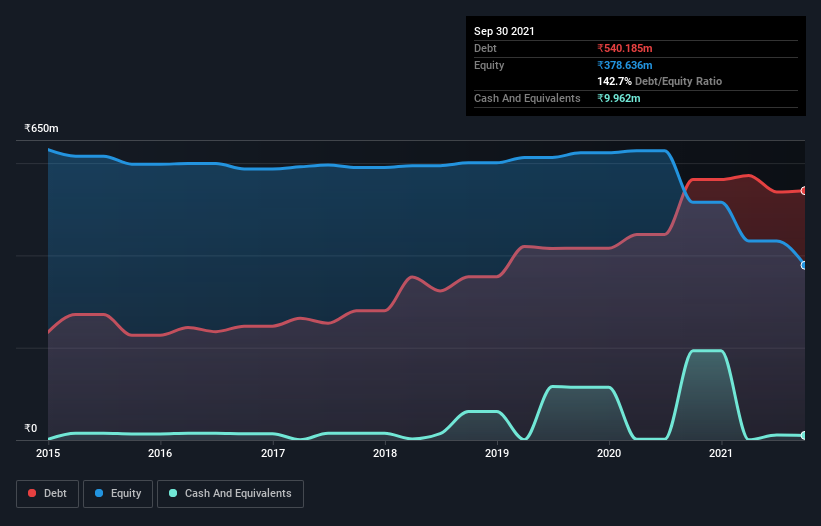
Warren Buffett famously said, 'Volatility is far from synonymous with risk.' When we think about how risky a company is, we always like to look at its use of debt, since debt overload can lead to ruin. Importantly, Hilton Metal Forging Limited (NSE:HILTON) does carry debt. But the more important question is: how much risk is that debt creating?
When Is Debt Dangerous?
Debt is a tool to help businesses grow, but if a business is incapable of paying off its lenders, then it exists at their mercy. Ultimately, if the company can't fulfill its legal obligations to repay debt, shareholders could walk away with nothing. While that is not too common, we often do see indebted companies permanently diluting shareholders because lenders force them to raise capital at a distressed price. Having said that, the most common situation is where a company manages its debt reasonably well - and to its own advantage. The first thing to do when considering how much debt a business uses is to look at its cash and debt together.
See our latest analysis for Hilton Metal Forging
How Much Debt Does Hilton Metal Forging Carry?
As you can see below, Hilton Metal Forging had ₹540.2m of debt at September 2021, down from ₹564.2m a year prior. And it doesn't have much cash, so its net debt is about the same.

How Strong Is Hilton Metal Forging's Balance Sheet?
The latest balance sheet data shows that Hilton Metal Forging had liabilities of ₹524.7m due within a year, and liabilities of ₹166.2m falling due after that. Offsetting this, it had ₹9.96m in cash and ₹91.1m in receivables that were due within 12 months. So it has liabilities totalling ₹589.8m more than its cash and near-term receivables, combined.
This deficit casts a shadow over the ₹192.9m company, like a colossus towering over mere mortals. So we'd watch its balance sheet closely, without a doubt. At the end of the day, Hilton Metal Forging would probably need a major re-capitalization if its creditors were to demand repayment. When analysing debt levels, the balance sheet is the obvious place to start. But it is Hilton Metal Forging's earnings that will influence how the balance sheet holds up in the future. So if you're keen to discover more about its earnings, it might be worth checking out this graph of its long term earnings trend.
In the last year Hilton Metal Forging's revenue was pretty flat, and it made a negative EBIT. While that hardly impresses, its not too bad either.
Caveat Emptor
Importantly, Hilton Metal Forging had an earnings before interest and tax (EBIT) loss over the last year. Its EBIT loss was a whopping ₹148m. If you consider the significant liabilities mentioned above, we are extremely wary of this investment. That said, it is possible that the company will turn its fortunes around. Nevertheless, we would not bet on it given that it lost ₹160m in just last twelve months, and it doesn't have much by way of liquid assets. So while it's not wise to assume the company will fail, we do think it's risky. When analysing debt levels, the balance sheet is the obvious place to start. However, not all investment risk resides within the balance sheet - far from it. Be aware that Hilton Metal Forging is showing 3 warning signs in our investment analysis , and 2 of those shouldn't be ignored...
If you're interested in investing in businesses that can grow profits without the burden of debt, then check out this free list of growing businesses that have net cash on the balance sheet.
Valuation is complex, but we're here to simplify it.
Discover if Hilton Metal Forging might be undervalued or overvalued with our detailed analysis, featuring fair value estimates, potential risks, dividends, insider trades, and its financial condition.
Access Free AnalysisThis article by Simply Wall St is general in nature. We provide commentary based on historical data and analyst forecasts only using an unbiased methodology and our articles are not intended to be financial advice. It does not constitute a recommendation to buy or sell any stock, and does not take account of your objectives, or your financial situation. We aim to bring you long-term focused analysis driven by fundamental data. Note that our analysis may not factor in the latest price-sensitive company announcements or qualitative material. Simply Wall St has no position in any stocks mentioned.
Have feedback on this article? Concerned about the content? Get in touch with us directly. Alternatively, email editorial-team (at) simplywallst.com.
About NSEI:HILTON
Hilton Metal Forging
Manufactures and sells iron and steel forgings for oil and gas, refinery, and pharmaceutical industries in India.
Mediocre balance sheet low.
Market Insights
Community Narratives



